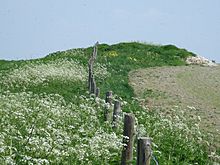|
|
|
|
Liddington Warren FarmLong Barrow
|
|
|
|
Images (click to view fullsize) |
|













|
Fieldnotes |
|
|
Liddington Warren Farm Long Barrow - May 11th 2008 This long barrow sits on top of a ridge over looking the B4192 from Liddington to Aldbourne. The road shows the precision of a Roman hand and I get the impression that this was the territory prized for it's fertility. This whole area of the Ridgeway was rich agricultural land long before any Roman marched here. The Aldbourne Circular Route, a bridleway/ride, follows the ridge and runs next to the barrow. The way this route follows the top of this ridge, from the old Ridgeway at Liddington Castle down to the Aldbourne Four Barrows and on into the church at Aldbourne, is very processional. This whole area must had been the height of pre-roman achievement. Once the Romans came, it would had mushroomed into a major agricultural complex. To visit this Barrow, I would suggest you park at SU 21822 80419, where the other cars pull up when visiting Liddington Castle, at the top of the hill. The traffic is slower here and you can see what's coming. This road is an accident black spot, as the signs proclaim. If you park here, there is a stile leading into the field and a straight track directly up to the barrow. If you want to get nearer, park at SU 22035 80044 and get under the wire. The road past this point is tree lined with Horse Chestnut trees and can get very dark. It is very wide too, with well dug side ditches and numerous pieces of sarsen half buried. I could imagine it being a drover's road, long before any car thundered along it. It would have been the main road out to Cirencester, the second largest city in Roman Britian. Walking up to the barrow you can see the fence line cutting the Eastern flank. This fence is the border. The parish was marked out on known landmarks and you don't get much older a Neolithic Long Barrow. The barrow has been mutilated by man and beast. The black and whites are resident here and they have made quite a mess. When the fence was erected in 1890, three skeletons were dug from the barrow with a fourth, that of an adult male, was found later. The bones of at least one of these were forwarded to St Thomas's Hospital. All are now lost. The barrow mound is ovoid in plan and orientated WNW-ESE.. It survives to 42m in length, is 30m wide and stands 1.5m high. Although no longer visible at ground level, flanking ditches, from which material was quarried during the construction of the monument, run parallel to the north and south sides of the mound. These have become in filled over the years but survive as buried features 3m wide. The barrow was first recorded by A.D. Passmore in 1922, who recorded a mound 165 feet long, 42 feet wide and up to 5 feet high, oriented SE-NW. Any sign of the side-ditches had been obliterated by ploughing. L.V. Grinsell was quoted as believing twelve sarsens protruding from the mound, although I could only see two. As it has never been properly excavated, these may be in situ from the original burial chamber. The hollow in the central area of the barrow mound represents only partial excavation by antiquarians, probably in the 19th century. There might not be a lot to see at this barrow, but it does date from the same period of the ancient Ridgeway. It survived for 5000 years, but has only fallen into a ruin in the last 100 years. |
 Posted by Chance
Posted by Chance12th May 2008ce Edited 12th May 2008ce |
Miscellaneous |
|
Opening of two barrows on Liddington Warren Farm, N. Wilts, 1893.The first barrow opened is close to a green road leading from Shepherd's Rest to Marlborough. It is a bowl-shaped barrow, and as it has been ploughed over for many years it has spread over a considerable space, its diameter from north to south being about 68ft., and from east to west 80ft., whilst its height is now only about 4ft. A trench was started on the south-east side, and at 13ft. from the centre the edge of a cairn of sarsens was reached, 3ft. in depth and built up on the original surface-level. The stones were so evenly built in that it was with difficulty that a pickaxe could be forced between them. Following these along they were found to rise within 6in. of the surface of the tumulus. When these had been removed to a depth of 4ft. the original chalk level was reached, when a cist was found in the centre full of burnt hones, on the top of which was the rim of an imperfectly burnt urn, and a small turned conical button pierced under its base in pulley fashion with a hole for the string, apparently of Kimmeridge shale, similar in shape to specimens now in the Stourhead Collection at Devizes. A. D. Passmore, Swindon W.A.M. No. 27 pages 175 to 176 |
 Posted by Chance
Posted by Chance28th February 2011ce |
|
Wiltshire Web mentions that: "This barrow is 150 feet long by 40 feet wide and only 4 feet high. The sarsens from the burial chamber protrude from the barrow. It is a local landmark used as a parish boundary. Three skeletons were found here in 1890 during the erection of a farm fence. " |
 Posted by Rhiannon
Posted by Rhiannon14th April 2003ce Edited 7th February 2006ce |

